Indigo Snake
Drymarchon
Indigo snakes use brute force to overpower their prey.
Advertisement
Indigo Snake Facts
- Prey
- Snakes, mammals, reptiles
- Group Behavior
- Solitary
- Fun Fact
- Indigo snakes use brute force to overpower their prey.
- Diet
- Carnivore
- Average Litter Size
- 4 to 12 eggs
- Lifestyle
- Diurnal
- Common Name
- Indigo snake
- Location
- North America, Central America, South America
View all of the Indigo Snake images!
Indigo Snake Summary
Indigo snakes belong to the genus, Drymarchon, which means “Lord of the Forest.”
Drymarchon is a genus of large non-venomous snakes commonly known as indigo snakes or cribos. Reaching lengths of 3 m (9.8 ft), indigo snakes are among the largest snakes in North America and can be found in the southern and southwestern United States, Central America, and South America. These gorgeous snakes are quite impressive with their iridescent blue-black, olive-brown or yellow scales, huge size, and fearless hunting abilities.
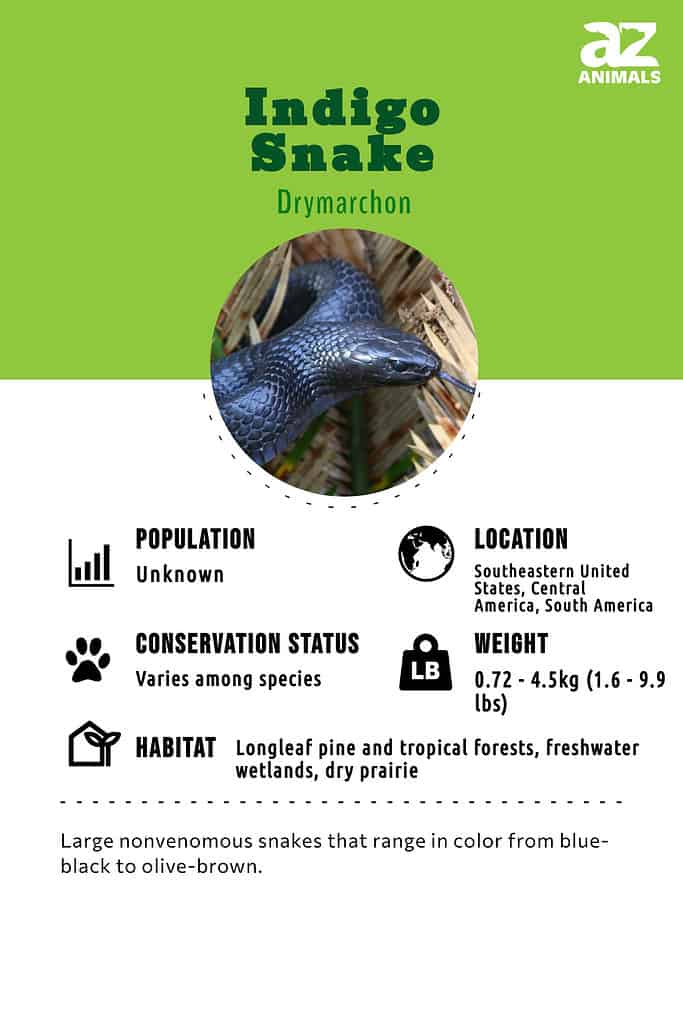
4 Amazing Facts About Indigo Snakes
• They are the longest snakes native to the U.S.
• Some indigo snakes will attack and eat venomous snakes.
• They emit a foul odor to defend themselves.
• Some rattle their tails when cornered or frightened.

Some indigo snakes attack and eat venomous snakes.
© Copyright krs10ellington some rights reserved (CC-BY-NC) – Original / License
Species
Until recently, Drymarchon corais was considered to be the nominative indigo snake with several subspecies. Now, the genus includes five distinct species:
- Indigo snake, yellow-tailed indigo snake, (Drymarchon corais) – can be found in South America, including Brazil, Columbia, Ecuador, French Guiana, Guyana, Peru, Suriname, Venezuela, Trinidad, and Tobago.
- Falcon indigo snake, (Drymarchon caudomaculatus) – this newly discovered species can be found in Venezuela and was previously thought to be a sub-species of the Middle American indigo snake.
- Eastern indigo snake, (Drymarchon couperi) – the longest native snake species in North America, this indigo snake can be found in the southeastern region of the United States.
- Margarita indigo snake, (Drymarchon margaritae) – this elusive indigo snake can only be found on the Margarita Islands, Venezuela.
- Middle American indigo snake, black-tailed cribo, (Drymarchon melanurus) – this sizeable indigo snake is native to the southwestern United States, Mexico, Central America, and northern South America. It has five subspecies: Drymarchon melanurus erebennus, Drymarchon melanurus melanurus, Drymarchon melanurus orizabensis, Drymarchon melanurus rubidus, and Drymarchon melanurus unicolor.

Evolution
Fossil records show that snakes first appeared during the Cretaceous period – although they often retained their hind limbs. The earliest true snake fossils come from the marine simoliophiids, the oldest being Haasiophis terasanctus, dated between 112 and 94 million years ago.
Scientists believe that snakes descended from lizards. Pythons and boas, the most primitive snakes, have vestigial hind limbs and some have remnants of a pelvic girdle, appearing as horny projections.
Many modern snakes originated during the Paleocene, alongside the radiation of mammals that occurred after the extinction of non-avian dinosaurs. The expansion of grasslands in North America led to a major radiation of snakes. During the Miocene, the number of snake species increased with the first vipers and elapids and the diversification of Colubridae.
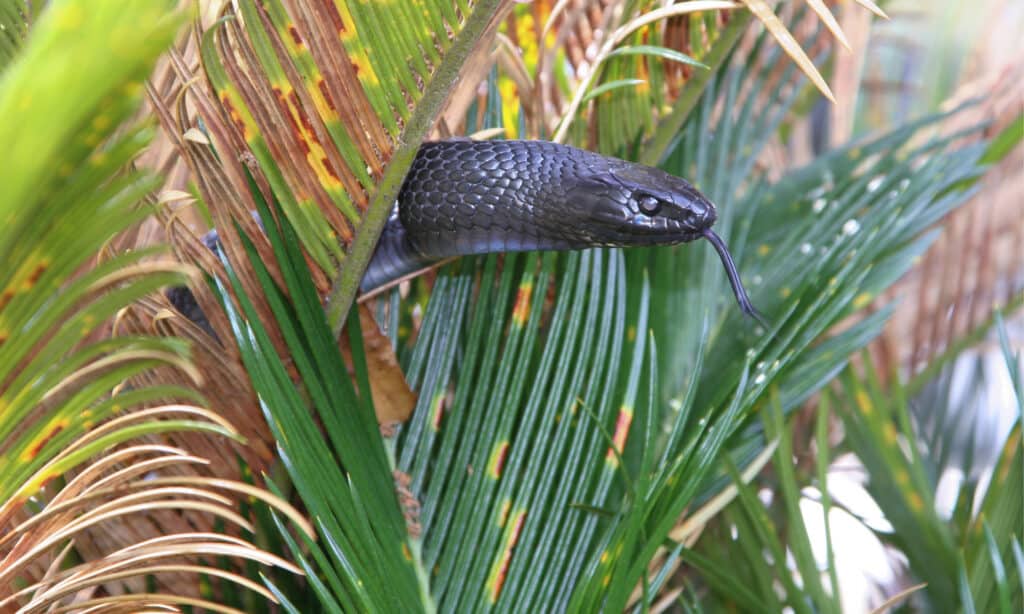
Indigo snakes use burrows of other animals as their winter shelters.
©iStock.com/sstaton
Behavior
An indigo snake usually sets up a hunting range of about three miles. This territory includes the snake’s preferred burrows and water sources.
Indigo snakes brumate during the coldest part of the winter. When temperatures drop below the 50s at night, they seek out the burrows of other animals, especially gopher tortoises, as they’re hiding places during this time. Typically, they use the same burrow every winter, which is why the loss of gopher burrows had a powerful impact on their survival. Indigo snakes in areas without gopher tortoises use the burrows of rodents, armadillos, or land crabs as their winter shelters.
The indigo mates from October to February, and the female produces a yearly clutch of 6 to 12 eggs. Baby indigo snakes are 16 to 24 inches long at birth.
Harmless To Humans
Indigo snakes are harmless to humans, but the reverse cannot be said. Humans are the primary cause of the snake’s decline in population. Humans have illegally taken indigo snakes for the pet trade, and increased development in the snake’s territory has caused death from domestic pets, car accidents, and pesticides.
Because indigo snakes are protected by U.S. law, it is illegal to handle one without a special permit and special training.
Yellow-tailed Indigo Snake
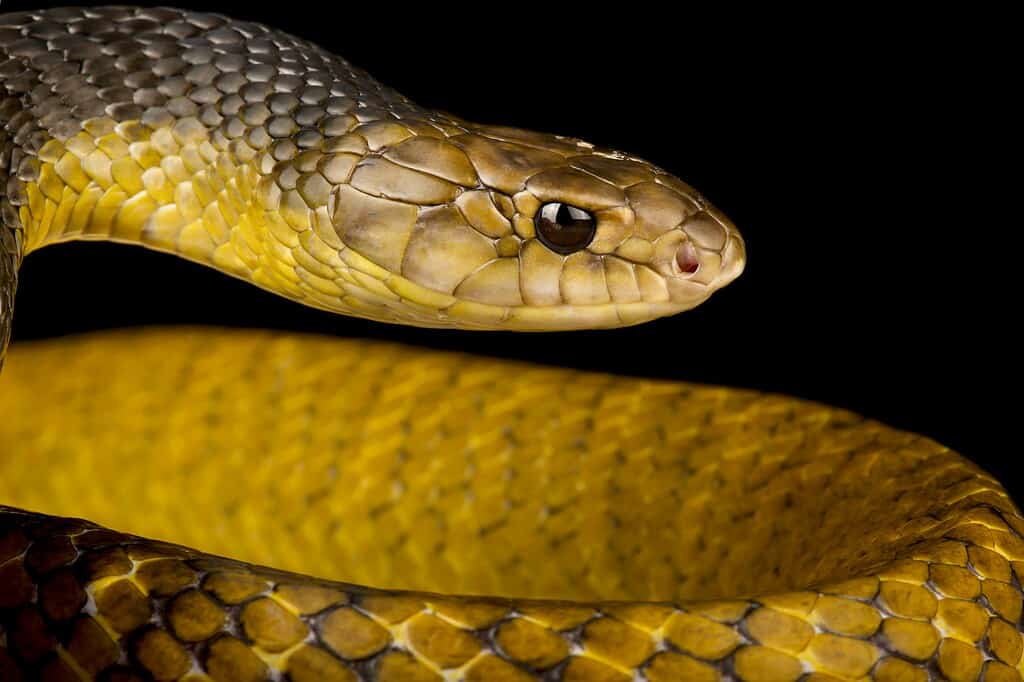
The yellow-tailed indigo snake is native to many countries in South America.
©reptiles4all/Shutterstock.com
This indigo snake can be found across much of South America, and until recently, was considered the nominative indigo species. Now, it is one of five distinct species. The yellow-tailed indigo snake forages on the ground and typically preys on fish, frogs, reptiles, reptile eggs, small mammals, birds, and bird eggs. Like all indigo snakes, this species is strikingly beautiful with smooth brown and yellow scales that end in a yellow tail.
Middle American Indigo Snake

Texas indigo snakes
are large active snakes that flush out prey and then overpower it.
©Radiant Reptilia/Shutterstock.com
This species of indigo snake contains five subspecies – including the Texas indigo snake (Drymarchon melanurus erebennus). Middle-American indigo snakes can grow up to 8 feet in length and can be distinguished from other indigos by coloration. This species has olive-brown, glossy scales that evolve to black at the tail. Their bellies are a lighter shade of olive-tan or olive-yellow. Distinctive dark markings around the eyes, a vertical dark slash behind the jaw, and heavy dark slashes on both sides of the neck further indicate a Middle-American indigo.
Falcon Indigo Snake
This beautiful indigo snake is a newly discovered species found in Venezuela. Like other indigos, this snake is large and hunts on the ground. Unlike other indigos, it is gold and brown with smooth scales and a lighter underbelly.
Margarita Indigo Snake
This elusive indigo snake can only be found on the Margarita Islands off the coast of Venezuela. No photos are available but it is said to have the traits of all indigo species and is black and brown in color.
Eastern Indigo Snake
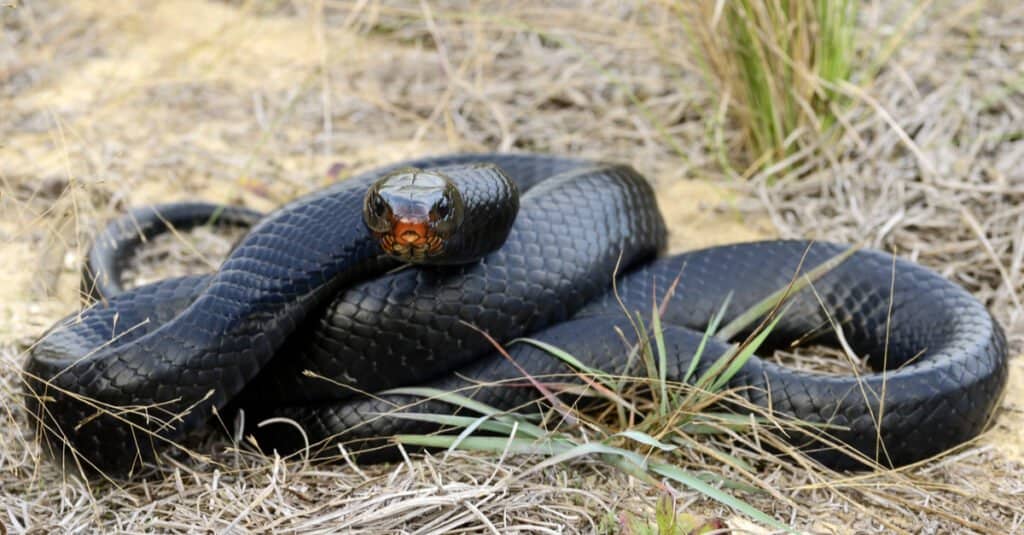
The Eastern Indigo Snake is the longest snake in North America.
©Patrick K. Campbell/Shutterstock.com
Although it once had a wide range through Alabama, Florida, Georgia, and Mississippi, the eastern indigo snake mostly lives in Florida and southeast Georgia. This snake prefers densely forested, warm, humid environments. Its preferred habitats are longleaf pine forests, dry prairies, tropical hardwood forests, coastal dunes, and freshwater marshes. The best places to see eastern indigo snakes are preserves like Everglades National Park in Florida.
One way to identify an adult eastern indigo snake is by its size. With the ability to grow up to 7 feet long, it is the longest snake native to the U.S. It has smooth scales and is a dark blue-black that can appear iridescent purple in some light. There are other black snake species, including the black pine snake, kingsnake, and black racer. If you want to be sure you’re looking at an eastern indigo snake and not another species, look for the following signs:
• Cream-colored or reddish spots on the chin, head, and throat
• Length of 5 to 7 feet
• Smooth scales
• No patterns or banding
Conservation of Eastern Indigo Snake
Although they are listed as “least concern” by the International Union for the Conservation of Nature (IUCN), eastern indigo snakes are considered threatened under U.S. law. In 1978, they were listed as a protected species under the Endangered Species Act.
The size of the snake’s population is unknown. The species suffered dramatic population declines caused primarily by collectors for the illegal pet trade. Another major threat has been rattlesnake hunters who destroyed gopher tortoise burrows to find the rattlesnakes. Indigo snakes often share the burrows of gopher tortoises. Destroying these burrows left the snakes without shelter.
Since the destruction of these burrows in North Florida, fewer indigo snakes now live in the northern part of the state. They mostly live in southern Florida.
Efforts to preserve this species have focused on breeding them in captivity. It has been difficult because captivity is very stressful for indigo snakes, but some programs have had promising results.
In 2017, Auburn University and the Nature Conservancy began a 10-year program of reintroducing indigo snakes to their former range. The first snakes were released in the Apalachicola Bluffs and Ravines Preserve in Florida. This preserve has the longleaf pine habitat the snake flourishes in, and the release program is considered a conservation success story.
Zoo Atlanta has set up an indigo snake-hatching program to reintroduce the snake to its former territories in Alabama and Georgia. Since 2010, the zoo has been raising baby indigos for release into the wild. More than 150 have been released in the Conecuh National Forest in southern Alabama. In 2020, the first baby indigo snake was spotted in the Conecuh, which means the snakes have established nesting and breeding sites there.
Diet
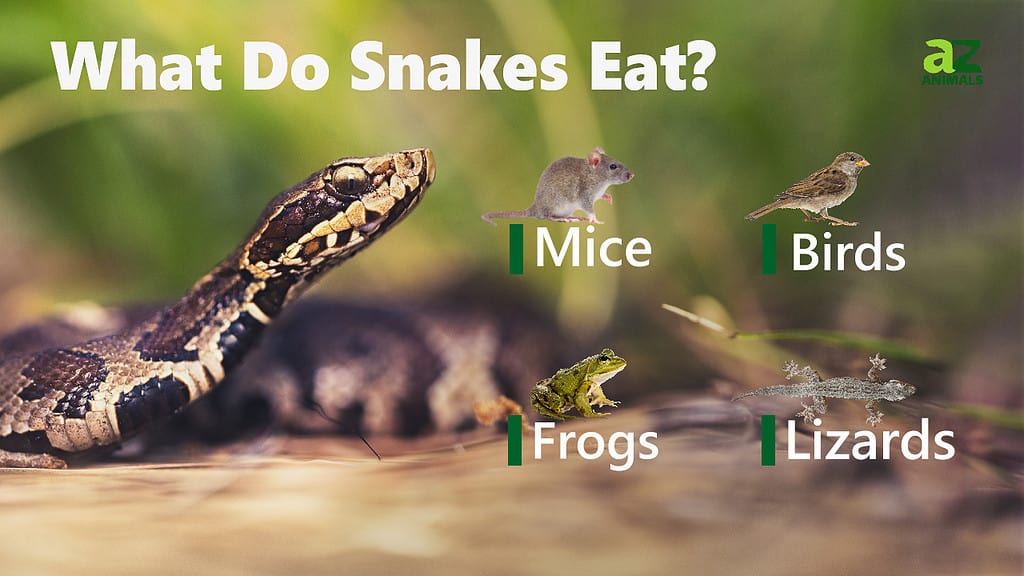
Indigo snakes are carnivores, and they are usually the apex predator in their ecosystem. These large snakes regularly consume other, smaller snakes as their regular prey.
They also kill and eat venomous snakes, including diamondback rattlesnakes, cottonmouths, and copperheads. They can get bitten during these attacks, but they are immune to snake venom. Their diet consists of:
• Snakes
• Turtles
• Turtle eggs
• Tortoises
• Baby alligators
• Lizards
• Rodents
• Fish
• Frogs
• Toads
How Dangerous Are Indigo Snakes?
These snakes are not venomous, so their bite carries no chance of envenomation.
FAQ About Indigo Snakes
Are indigo snakes venomous?
No, indigo snakes are not venomous.
How do they hunt?
These snakes wait for prey to cross their territory, and then they strike with their teeth. They usually eat the heads first.
Are indigo snakes aggressive?
Like many snakes, they can be aggressive when attacked. Indigo snakes rarely bite humans. If it happens, their bite may be painful, but it’s not poisonous. They will, however, attack their prey or enemies very aggressively. Male indigo snakes attack each other when competing for mates.
If frightened or attacked, these snakes make a unique defensive response. They flatten their necks, hiss loudly, and make the tips of their tails vibrate. This creates a buzzing or rattling sound. They may also respond by releasing a foul smell from their anal glands.
Where do indigo snakes live?
The indigo snake prefers warm, humid climates and longleaf pine forests. Snakes in northern Florida hibernate in the winter, but those in the southern part of the state rarely need to because it doesn’t get that cold. Indigo snakes can be found in Central and South America.
References
U.S. Fish and Wildlife Service: Eastern Indigo Snake.
Nature Conservancy: Eastern Indigo Snake.
National Park Service: Everglades National Park Species Spotlight.
Indigo Snake FAQs (Frequently Asked Questions)
Are indigo snakes venomous?
No, indigo snakes are not venomous.
How do they hunt?
These snakes wait for prey to cross their territory, and then they strike with their teeth. They usually eat the heads first.
Are indigo snakes aggressive?
Like many snakes, they can be aggressive when attacked. Indigo snakes rarely bite humans. If it happens, their bite may be painful, but it’s not poisonous. They will, however, attack their prey or enemies very aggressively. Male indigo snakes attack each other when competing for mates.
If frightened or attacked, these snakes make a unique defensive response. They flatten their necks, hiss loudly, and make the tips of their tails vibrate. This creates a buzzing or rattling sound. They may also respond by releasing a foul smell from their anal glands.
Where do indigo snakes live?
The indigo snake prefers warm, humid climates and longleaf pine forests. Snakes in northern Florida hibernate in the winter, but those in the southern part of the state rarely need to because it doesn’t get that cold.
What do indigo snakes eat?
They are carnivores, and they are usually the apex predator in their ecosystem. These large snakes regularly consume other, smaller snakes as their regular prey.
They also kill and eat venomous snakes, including diamondback rattlesnakes, cottonmouths, and copperheads. They can get bitten during these attacks, but they are immune to the snake venom. Their diet consists of:
• Snakes
• Turtles
• Turtle eggs
• Tortoises
• Baby alligators
• Lizards
• Rodents
• Fish
• Frogs
• Toads
Are there any indigo snakes in Texas?
No, there are no indigo snakes in Texas. Most of Texas is hot and dry, and indigo snakes prefer warm, humid wetlands.
What is the difference between an Indigo snake and a black racer?
The major difference is that Black racers weigh only 1-2 pounds, while indigo snakes weigh between 4-10 pounds. Indigo snakes can be found only in the southeastern United States, in Florida, Georgia, Alabama, and Mississippi. Black racers also live in the southeastern part of the United States, but they can be found as far north as southern Maine, and far west as eastern Texas.
Thank you for reading! Have some feedback for us? Contact the AZ Animals editorial team.
Sources
- U.S. Fish and Wildlife Service: Eastern Indigo Snake. (1970)
- Nature Conservancy: Eastern Indigo Snake. (1970)
- National Park Service: Everglades National Park Species Spotlight. (1970)


















